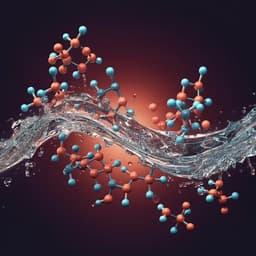
Earth Sciences
Cosmic dust fertilization of glacial prebiotic chemistry on early Earth
C. R. Walton, J. K. Rigley, et al.
This groundbreaking research reveals how cosmic dust may have played a pivotal role in fertilizing prebiotic reactions on early Earth, challenging previous assumptions about the availability of bioessential elements. Conducted by a team led by Craig R. Walton and including Jessica K. Rigley, Alexander Lipp, Robert Law, Martin D. Suttle, Maria Schönbächler, Mark Wyatt, and Oliver Shorttle, this study uncovers remarkable insights into our planet’s early chemistry.
Playback language: English
Introduction
The origin of life hinges on the availability of bioessential elements (P, S, N, C) in reactive forms. Experiments show that moderate to high concentrations of simple molecules can yield biologically relevant molecules like nucleic acids, lipids, and peptides. However, common terrestrial rocks are deficient in these reactive forms. Life today possesses complex enzymatic machinery to extract these elements even at low concentrations. Prebiotic chemistry, lacking such mechanisms, requires a different explanation for the concentration of essential elements. One possibility is the exogenous delivery and concentration of these elements via cosmic dust. Cosmic dust, comprising fine-grained mineral aggregates from asteroids and comets, contains these bioessential elements in higher concentrations than Earth's crust. Its constant flux offers a more reliable and less destructive delivery method compared to large impactors. While its initial distribution is dilute, various sedimentary processes, like aeolian, fluvial, and glaciogenic sorting, can concentrate cosmic dust significantly. This study investigates whether these processes could have formed concentrated cosmic dust deposits on early Earth, sufficient to fertilize prebiotic chemistry. We use astrophysical simulations and geological models to quantify the flux and composition of accreted cosmic dust and its concentration in various environments. This allows us to assess whether such deposits could have plausibly acted as a fertilizer for prebiotic reactions, filling a major gap in our understanding of prebiotic chemistry's geological context.
Literature Review
Previous research highlights the importance of concentrated feedstocks for prebiotic chemistry. Studies demonstrate the synthesis of biologically relevant molecules from simple precursors under specific conditions. However, the challenge lies in identifying plausible geological mechanisms that could provide these concentrated feedstocks on early Earth. While the role of larger impactors in delivering bioessential elements has been explored, the continuous and less destructive delivery of cosmic dust has received less attention. Some studies have noted the potential of sedimentary processes to locally concentrate cosmic dust, suggesting a link to the origin of life. But there has been a lack of quantitative models to assess the extent of this concentration and the resulting impact on prebiotic chemistry. This study addresses this gap by creating a quantitative model of cosmic dust supply and surface cycling on early Earth, building upon existing research on cosmic dust composition, atmospheric entry, and sedimentary processes.
Methodology
This study combined astrophysical simulations and geological models to quantify the flux and composition of cosmic dust on early Earth. Astrophysical simulations modeled the generation, interplanetary transport, and accretion flux of dust from Jupiter-family comets (JFCs) and asteroids, considering different dust source populations (main belt asteroids, unstable planetesimals, and scattered comets). These simulations spanned the first 500 million years after the Moon-forming impact. The models accounted for factors like a more massive early asteroid belt, giant planet migration, and collisional erosion of leftover planetesimals from planet formation. The simulations generated grain-size frequency distributions for the accretion flux, revealing a bimodal distribution similar to observed cosmic dust deposits today, but with a potentially higher overall mass flux and different compositional makeup. A key finding was the significant proportion of volatile-rich cometary dust in the early accretion flux. Geological models were then developed to predict the proportion of cosmic dust within sediments by considering dust input rate, endogenous sediment supply, and local concentration mechanisms. Different sedimentary environments (glacial surfaces, hot deserts, deep-sea sediments) were modeled. Empirical data on the present-day cosmic dust concentration in these environments were used to ground-truth the calculations. To minimize uncertainty, the study assumed early Earth environmental parameters similar to present-day values except for the cosmic dust accretion rate. The model predicted higher cosmic dust proportions in environments with low endogenous sediment production and efficient concentration mechanisms, notably glacial ablation zones (cryoconite sediments). Further analysis combined estimates of cometary and asteroidal dust contributions with their respective elemental (C, N, P, S) concentrations to predict the chemical composition of putative early Earth cosmic dust deposits. The effects of atmospheric entry on volatile loss were also accounted for. A crucial aspect considered was the potential difference in nitrogen loss during atmospheric entry between an oxidizing (present-day) and a reducing (potential early Earth) atmosphere. Overall, the model estimated the concentration of key elements (P, S, N, C) in cryoconite sediments relative to average upper continental crust, examining variations with different levels of cometary input and considering potential short-lived periods of heightened dust flux following parent body break-up events.
Key Findings
The study's astrophysical simulations showed that early Earth experienced significantly higher cosmic dust accretion fluxes (100 to 10,000 times higher than present) due to a more massive early asteroid belt, giant planet migration, and collisional erosion. Cometary dust constituted a substantial part of this flux, with periods of high-flux cometary dominance. Geological modeling predicted that cosmic dust could constitute a significant fraction of sediments (>50%) in desert and glacial settings, reaching exceptionally high concentrations (>80%) in glacial ablation zones (cryoconite sediments). Deep-sea sediments, in contrast, showed minimal cosmic dust concentration. Cryoconite sediments were predicted to be significantly enriched in bioessential elements (up to 100-fold) compared to average upper continental crust, with the highest enrichments seen during periods of enhanced cometary delivery. The model showed that episodes of large cometary break-up events could cause short-lived but significant spikes (order of magnitude) in cosmic dust flux, leading to exceptionally high concentrations of bioessential elements in sediments. These findings were robust to various assumptions made in the model, including those regarding the composition of terrestrial sediments and the effects of atmospheric entry. The study also found that while soluble P and S from cosmic dust (schreibersite, apatite, etc.) would have been readily available for prebiotic reactions, the insoluble C and N-rich organic components (kerogen, etc.) could have accumulated in sediments, providing a stockpile for prebiotic reactions. The model also examined the impact of different atmospheric conditions on nitrogen retention, showing that a reducing early atmosphere could have preserved more nitrogen from cosmic dust during atmospheric entry compared to today’s oxidizing atmosphere. The study suggests that glacial environments, specifically cryoconite fields and associated proglacial lakes, represent optimal locations for prebiotic chemistry due to dust concentration and the presence of liquid water. These environments offer several advantages for prebiotic chemistry: freeze-thaw cycles, low water-rock ratios, and potential for UV irradiation and shielding. The model highlights the unique advantages of cosmic dust-rich sediments over terrestrial sediments in providing fine-grained, reactive forms of phosphorus and sulfur, crucial for prebiotic reactions.
Discussion
The findings suggest that cosmic dust-rich cryoconite deposits provide a plausible scenario for prebiotic chemistry. However, the transient nature of most cryoconite holes poses a challenge. The study acknowledges that the continuous meltwater drainage might dilute prebiotically relevant species. However, the model points to Antarctic-like dry valley settings with impermeable ice lids, where cryoconite holes can persist longer. These environments, by analogy, could have existed on early Earth, sustaining abiotically enriched conditions conducive to prebiotic chemistry. Even in these stable settings, ice dynamics still cause eventual destabilization and transport of cryoconite to proglacial lakes. These lakes offer a location where longer-term stockpiling of dust-derived species might occur. The combination of concentrated cosmic dust deposits and closed aqueous systems like proglacial lakes provides multiple ideal environments for prebiotic chemistry. These systems could have operated as a network of interacting 'reactors', with favorable conditions for chemical reactions. The study particularly emphasizes the unique contribution of cosmic dust in supplying reactive phosphorus and sulfur, which are scarce on Earth. The fine grain size of cosmic dust particles aids dissolution, thus enhancing the availability of these elements. The model indicates that the combination of cosmic dust-derived P, S, and potentially C and N from the stockpiled organic components could have facilitated early prebiotic chemistry. The plausibility of this scenario depends on whether early Earth had sufficient glacial environments. While glaciers existed up to 2.5 billion years ago, and recent models suggest a cold early Earth, further investigation into early Earth climate is necessary to strengthen this hypothesis.
Conclusion
This study provides strong evidence for the hypothesis that cosmic dust, through concentration in glacial settings, could have significantly fertilized prebiotic chemistry on early Earth. The model predicts high concentrations of bioessential elements in cryoconite sediments, especially during periods of increased cometary input. The unique properties of these glacial environments—along with the readily available reactive P and S and stockpiled C and N—made them ideal locations for the initiation and maintenance of prebiotic chemistry. Future research should focus on further refining the models by incorporating more detailed information on early Earth’s climate and geological conditions, and exploring the potential impact of other factors, such as volcanic activity, on cosmic dust distribution and concentration. Understanding the prevalence of glacial environments on early Earth will be crucial for evaluating the broader significance of this proposed mechanism for prebiotic chemistry. Furthermore, this research has implications for the search for life beyond Earth. The potential for cosmic dust as a widespread planetary fertilizer should be considered when assessing the habitability of exoplanets.
Limitations
The model relies on assumptions about early Earth's environmental parameters. While efforts were made to minimize uncertainty by using present-day values for most parameters, variations in factors like atmospheric composition, ice sheet dynamics, and the rate of endogenous sediment production could affect the predicted cosmic dust concentrations. The model assumes that concentration mechanisms operate with the same efficiency at higher dust accretion rates. While justifiable for the low sedimentation environments considered, deviations from this assumption could alter the results. Uncertainty in the composition and abundance of early Earth’s crust also affects the extent of enrichment from cosmic dust. The study focuses mainly on glacial environments and may underestimate the contribution of other environments in concentrating cosmic dust. Finally, detailed knowledge of the chemical transformations and interactions of cosmic dust components during atmospheric entry and within the sedimentary environment remains limited, introducing some uncertainty in the assessment of the availability of bioessential elements for prebiotic reactions.
Related Publications
Explore these studies to deepen your understanding of the subject.







